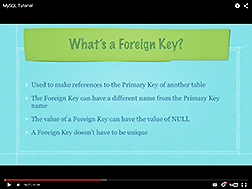Presenting Information
When discussing code or the way an application functions, it may be best to show the viewer how the information looks on the computer screen. However, having code or an application on the screen may be distracting to the viewer when presenting conceptual information. Rather than listening to the information being provided, the viewer may be waiting for action to happen on the screen. Generally, there are four ways to present information:
Software Demonstration

Most video documentation is in the form of a software demonstration. The video creator will record themselves using software to complete a task. This type of demonstration lets the viewer see the process for completing a task in action.
If any code is needed during the software demonstration, video creators may write out any lines of code they need before recording their video. They can then copy and paste the code into the application. This avoids creating an error while recording the video, but also does not show the creation or debugging process.
Live Coding

Live coding is the process of recording the video creator writing a program. The video creator writes out, debugs and runs the program for the viewer. This means the video recorder usually makes mistakes in their demonstration, and the viewer will have to watch them fix these errors. Some viewers may find it useful to see how the video creator solves the issues they come across.
If the video creator wants to talk about code without the possibility of making mistakes, there are alternatives to live coding. The video creator can show a fully written program that has been created before the video was made, and not make any code changes as they record. A verbal explanation of what the code is doing will make up for not seeing the code being typed.
Slides
 (#10)Slides may be used to present conceptual information, just like it was being presented in a speech. Slides may also be useful if specific syntax or example code is being presented. Slides emphasize ideas being discussed, and may help the viewer receive a visual reinforcement of new concepts.
(#10)Slides may be used to present conceptual information, just like it was being presented in a speech. Slides may also be useful if specific syntax or example code is being presented. Slides emphasize ideas being discussed, and may help the viewer receive a visual reinforcement of new concepts.
Personal footage
 (#8)Some video creators may film themselves discussing concepts, or introducing the video. This can make the video feel like it has a formal presenter and adds a personal touch to the video. When the presenter is not seen, it may feel like the video is an anonymous example of a technology, rather than something presented by an actual human. While developers enjoy the social and personal aspects of video documentation, a video creator should decide whether slides are more effective than showing footage of themselves talking.
(#8)Some video creators may film themselves discussing concepts, or introducing the video. This can make the video feel like it has a formal presenter and adds a personal touch to the video. When the presenter is not seen, it may feel like the video is an anonymous example of a technology, rather than something presented by an actual human. While developers enjoy the social and personal aspects of video documentation, a video creator should decide whether slides are more effective than showing footage of themselves talking.
